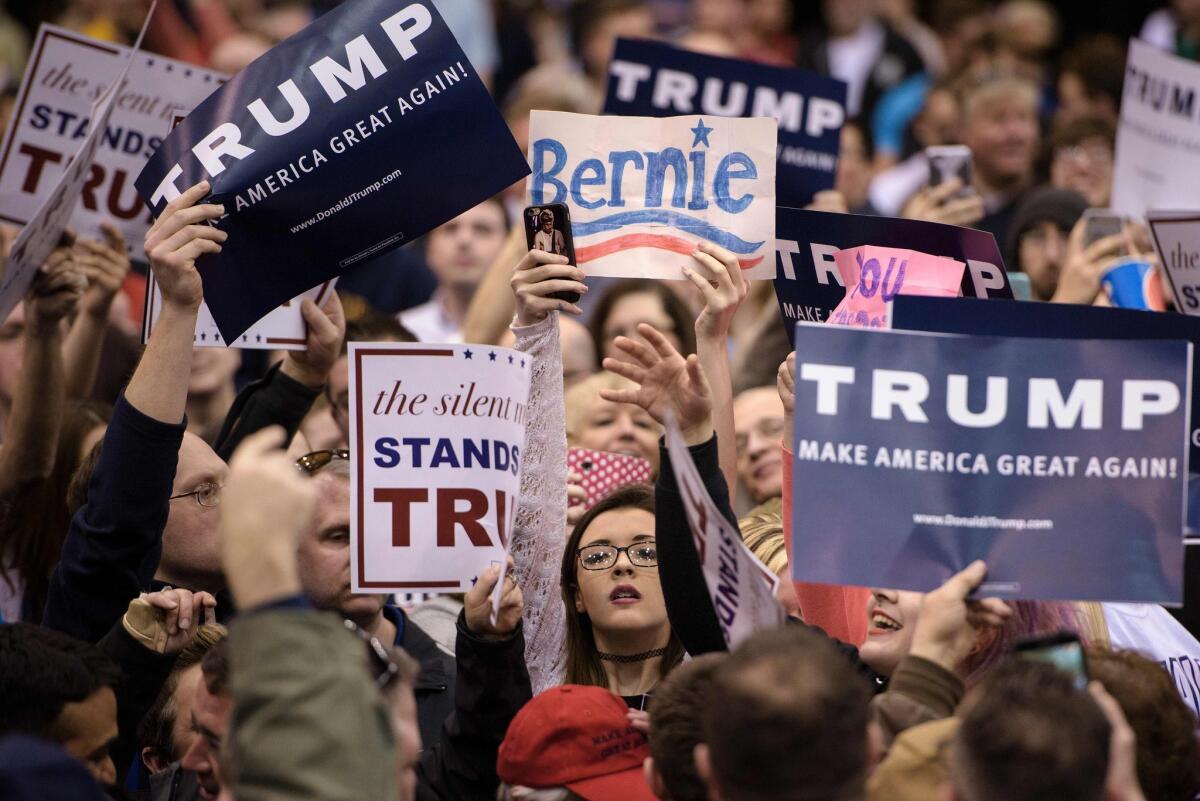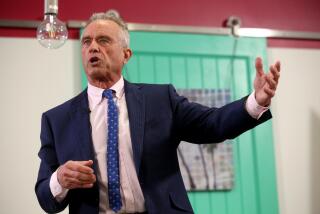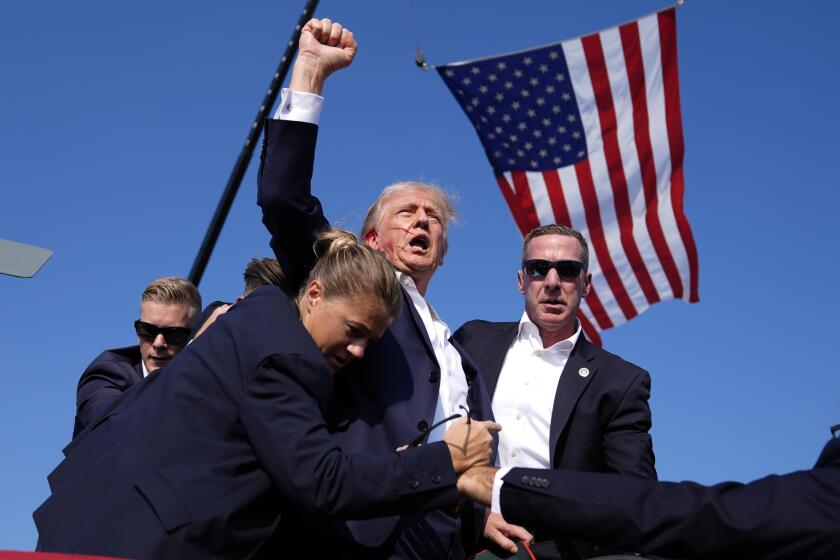Analysis:: For Donald Trump, protests create a short-term benefit and a long-term threat

A supporter of Democratic candidate Bernie Sanders holds up a sign during a Donald Trump rally Saturday in Cleveland. The Republican candidate blames Sanders supporters for instigating violence at a Trump event in Chicago, which was canceled for security reasons.
Reporting from Cleveland â A flammable brew of populist anger, a candidateâs provocative remarks and disruptive protesters found a fuse, and the result, at what was to be a Donald Trump event in Chicago this weekend, was an explosion that continued to reverberate through the presidential campaign Saturday.
In a contest that has had far more than its share of drama, the question is: What happens next?
Trumpâs Republican opponents rushed to denounce him over the chaotic turn Friday night, and there was an urgency to their positions. Primaries will be held Tuesday in Ohio, Florida, North Carolina, Illinois and Missouri â and the campaigns of Ohio Gov. John Kasich and Florida Sen. Marco Rubio will probably end if they fail to win their home states. A substantial series of victories by Trump on Tuesday would move him a major step closer to a nomination that so many in his party are trying to block.
As Trump himself suggested, the latest controversy very likely will cement support for him among his backers, who have already weathered disputes over his caustic criticisms of ethnic groups, women, the disabled and the pope, to mention a few. Their allegiance is apt only to harden if they feel that their leader, and they by extension, are under attack.
Appearing at three rallies Saturday, Trump maintained the political style and message that has propelled him to front-runner status. At those events in Ohio and Missouri, he emerged unrepentant and defiant, blaming protesters, President Obama and other Democrats for the divisions that pushed the campaign to a new level of tension Friday night.
But two longer-term issues now threaten him, and those become more difficult as time goes on without a change in strategy by Trump.
Reading the political moment with far more dexterity than anyone else running for president this year, Trump has succeeded to this point on the strength of his many loyalists and a fractured opposition.
He has excelled in playing competitors against one another and has benefited as they fought among themselves for the role of prime challenger. A fight against just one of them â say, Texas Sen. Ted Cruz, if Kasich and Rubio falter â focuses the race in a different way and could result in all of the anti-Trump vote coalescing around one person. Trumpâs opponents have hoped that since his support in primaries so far has rarely risen above the low 40% range, a one-on-one race might allow victory for the anti-Trump candidacy.
That could be a long-shot. But if Trump does win the nomination, he faces a much bigger problem, one that the escalation of protests around his events highlights: Having risen to the role of front-runner by playing to the emotions of a vocal, aggrieved minority of his party, how does he pivot toward a broader constituency that is less taken with his brand?
That broad constituency is becoming more and more difficult for any politician to command as each partyâs voters go to their partisan corners in growing numbers. In a 2014 study, the Pew Research Center found that 27% of Democrats and Democratic-leaning independents and 36% of Republicans and Republican-leaning independents felt that the other partyâs positions âare so misguided that they threaten the nationâs well-being,â a stark data point. And voters who felt that way were more likely to take part in the primaries.
Appealing to a wider group in a general election is particularly difficult for candidates like Trump, one of a long line of political figures who have played on the emotions of the crowd, often by using racial cues or outright statements of racial antagonism to enrage their followers and outrage their opponents.
This is a particularly fraught period for the country: Economic displacement has left many fearful and upset, at the same time tensions are rising over cultural shifts wrought by changes in the nationâs demographics. Those economic and cultural insecurities have combined to provide a receptive audience for Trumpâs surprisingly strong candidacy, but the tactics he has used to appeal to that audience have also alienated huge numbers of voters.
An NBC/Wall Street Journal poll last week found that two-thirds of voters overall â anti-Trump Republicans and Democrats â couldnât see a circumstance under which theyâd vote for Trump in November. A separate NBC News/SurveyMonkey tracking poll found a large percentage of nonwhite voters, the growing chunk of the electorate, were anti-Trump.
According to the survey, 86% of African American voters and 75% of Latino voters had an unfavorable view of Trump. All told, 7 in 10 nonwhite voters said they had a âveryâ unfavorable view of the man who, before Saturday, had won 14 of the 22 Republican contests.
Not surprisingly, black, Latino and Muslim young people were at the core of Fridayâs protests that led Trump to cancel a rally that he had scheduled at the University of Illinois campus in Chicago.
The visceral opposition that Trump has stirred among minority Americans contradicts his self-description as a âuniterâ â he accuses Obama of being âthe great dividerâ â and raises the question of whether he is able, or even wants, to make the kind of sharp turn in his strategy that might assuage the anger that has helped fuel his campaign.
So far, Trump has not backed down from any of the incendiary comments he has made about Mexicans, Muslims and people in China and Japan who he says are taking American jobs. Those comments, and his vow to build a wall on the Mexican border, have created an irreparable impediment to any steps he might try to take to broaden beyond his mostly white base.
Part of the horror felt by Republicans watching the spectacle over the weekend was that its imagery recalled a period the party has wanted to escape.
At the end of the last presidential campaign, party leaders drew up a report asserting that the next nominee had to have strong appeal to the young, to minority voters â particularly Latinos â and to women, three groups with whom 2012 nominee Mitt Romney did poorly. Trumpâs candidacy has been the antithesis of that, as women and Latinos have not just been ignored but insulted by him.
Trump protesters, having gotten the candidate to cancel one event, are unlikely to stop trying to disrupt him. At all three rallies he held Saturday, Trump was interrupted repeatedly by catcalling and shouting from opponents.
The candidate ended up shouting some version of âGet out!â dozens of times. Those shouts stirred his supporters, who cheered him on. But to the rest of the country, they broadcast the image of an angry white man yelling at members of the same young, minority and women voter blocs that Republicans said they wanted to attract. If Trump ends up as the GOP nominee, that image probably will prove a heavy burden.
Times staff writer Michael Finnegan in Los Angeles contributed to this report.
On Twitter: @cathleendecker . For more on politics, go to latimes.com/decker.
MORE ON CAMPAIGN 2016
Marco Rubio fights for his campaignâs future
How black, Latino and Muslim college students organized to stop Trumpâs rally in Chicago
As Republican rivals take aim, Donald Trump deflects blame for near-riot in Chicago
More to Read
Get the L.A. Times Politics newsletter
Deeply reported insights into legislation, politics and policy from Sacramento, Washington and beyond. In your inbox three times per week.
You may occasionally receive promotional content from the Los Angeles Times.











